Instruction
Stickney: 8 quick tips for better golf
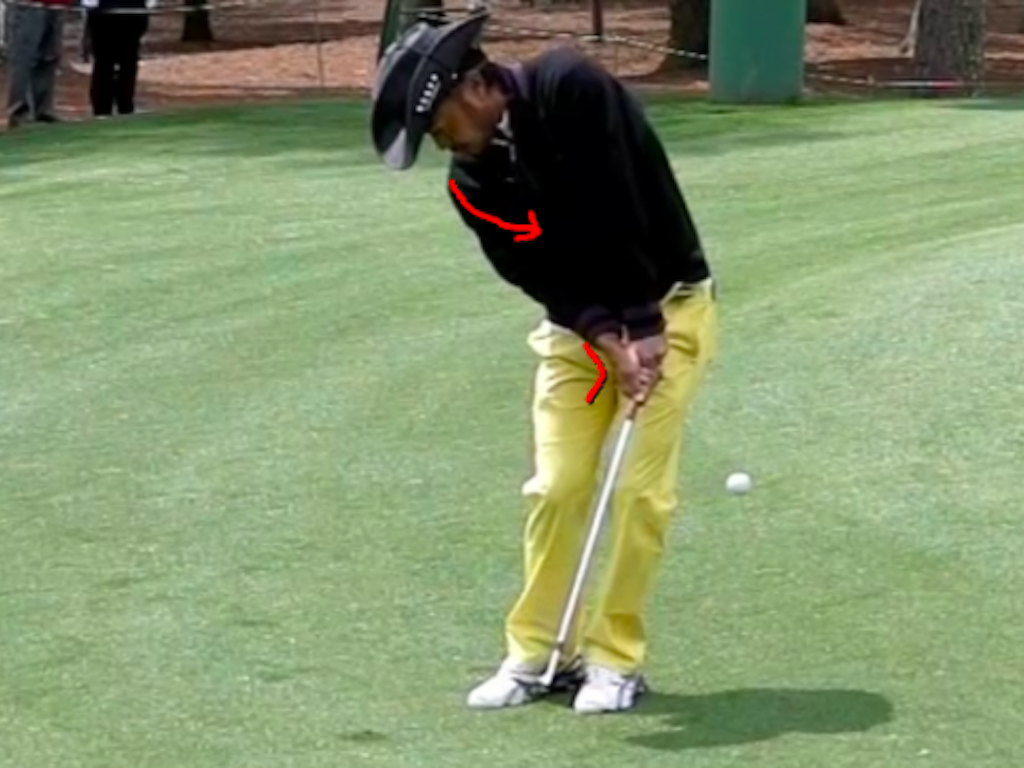
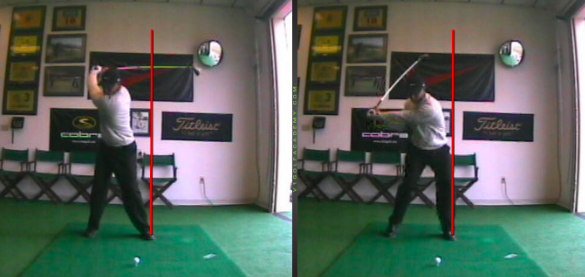
One of the biggest myths in the golf swing is that you only “rotate or turn your hips” during the transition. Of course, you must rotate them at some point but as you see Tiger here in the photo above there is a very distinct bump AS the hips begin to rotate. If you only rotate you will tend to stay on your rear foot during the downswing causing over the top transitions and poor quality impact!
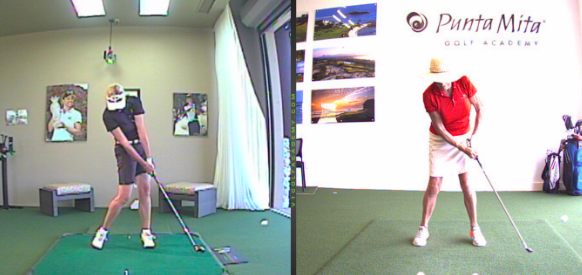
Most average players have trouble compressing the golf ball and hitting the ball solidly during impact. In fact, the thin and “clicky” shot is more often hit than not. This shot comes from the absence of longer arms through impact and whenever you “pull up” through the shot you will tend to hit the equator of the golf ball. As you look at this LPGA Tour player in the left frame you will see long arms and more solid impact!

Attention women, you have more flexibility than 10 men and this can be an issue when you play golf. As you can see in these photos the LPGA player on the left has a tighter turn to the top allowing a more explosive downswing! The player on the right has wasted too much motion on the backswing and therefore will have trouble producing speed through impact!
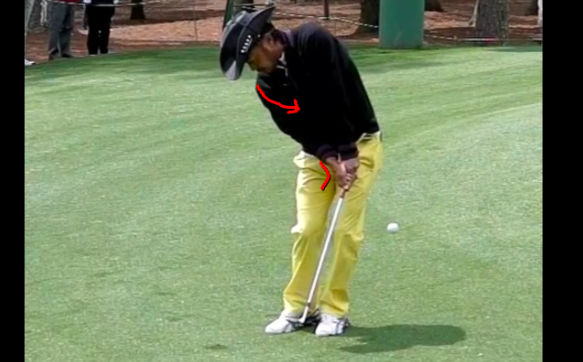
When pitching, it’s easy to forget about using the pivot of the body and only focusing on using the arms. As you can see in the photo above this player is rotating his rear shoulder through the shot keeping the rear wrist in a great condition for solid impact. If you only use your arms here you will tend to “flip” at the ball and use your hands too much making quality impact a fleeting thing.

One of my favorite ways to look at the putting stroke is from the hole back to the player. As you can see, Rory has hit the ball in the left frame and continues into his follow through in the right frame. What you can see is that the putter continues down the line with little twisting and turning of the blade post-impact. As we know the stroke works in an arc and the face will close on its own but it’s not your job to “release” it or try and make it happen on your own. Just let it flow!
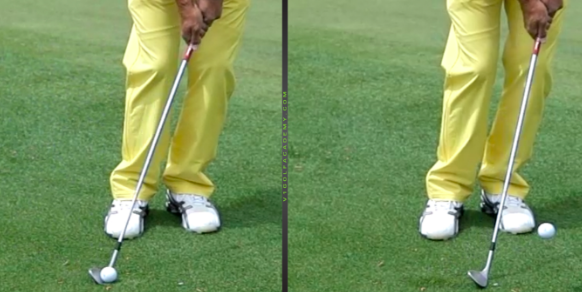
To be a good pitcher of the golf ball you must do two things around the green…number one, just bruise the turf coming through impact and have some type of shaft lean forward (SLIGHT). If you possess these two things then you will have a much better chance of hitting good solid shots around the green. If you come into the golf ball too steeply or have the shaft backing up through impact then you will find that you will have impact quality issues.
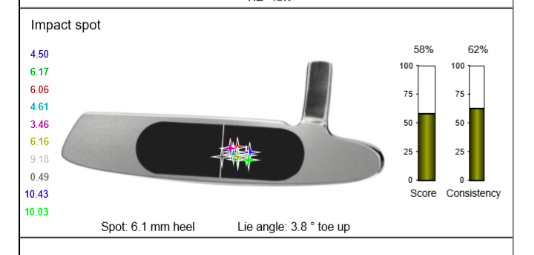
When it comes to club fitting most golfers have clubs that are fit to them when it pertains to the length and hopefully the lie but with putters 99% of all golfer don’t even consider fitting. Most putters come off the rack around 35 inches with a lie angle of 71 degrees…great if you fit this mold but if you do not your impact will tend to look like this one above. The putter is toe-up with a faulty impact location giving you inconsistent misses. Get your putter fit—length, loft, and lie and you will thank me.

If you want more distance and more consistent impact then you should work on having more “width” at the top. When the lead arm is straighter you will find that these things will happen automatically. If you want the lead arm in a better condition then check out your rear arm…that is the controller! If the rear arm is at 90 degrees or more, you will find the lead arm will be straighter. Try it and you’ll be walking farther down the fairway.
- LIKE44
- LEGIT2
- WOW0
- LOL1
- IDHT1
- FLOP1
- OB1
- SHANK6
Instruction
Clement: Laid-off or perfect fade? Across-the-line or perfect draw?

Some call the image on the left laid off, but if you are hitting a fade, this could be a perfect backswing for it! Same for across the line for a draw! Stop racking your brain with perceived mistakes and simply match backswing to shot shape!
- LIKE0
- LEGIT0
- WOW0
- LOL0
- IDHT0
- FLOP0
- OB0
- SHANK1
Instruction
The Wedge Guy: The easiest-to-learn golf basic

My golf learning began with this simple fact – if you don’t have a fundamentally sound hold on the golf club, it is practically impossible for your body to execute a fundamentally sound golf swing. I’m still a big believer that the golf swing is much easier to execute if you begin with the proper hold on the club.
As you might imagine, I come into contact with hundreds of golfers of all skill levels. And it is very rare to see a good player with a bad hold on the golf club. There are some exceptions, for sure, but they are very few and very far between, and they typically have beat so many balls with their poor grip that they’ve found a way to work around it.
The reality of biophysics is that the body moves only in certain ways – and the particulars of the way you hold the golf club can totally prevent a sound swing motion that allows the club to release properly through the impact zone. The wonderful thing is that anyone can learn how to put a fundamentally sound hold on the golf club, and you can practice it anywhere your hands are not otherwise engaged, like watching TV or just sitting and relaxing.
Whether you prefer an overlap, interlock or full-finger (not baseball!) grip on the club, the same fundamentals apply. Here are the major grip faults I see most often, in the order of the frequency:
Mis-aligned hands
By this I mean that the palms of the two hands are not parallel to each other. Too many golfers have a weak left hand and strong right, or vice versa. The easiest way to learn how to hold the club with your palms aligned properly is to grip a plain wooden ruler or yardstick. It forces the hands to align properly and shows you how that feels. If you grip and re-grip a yardstick several times, then grip a club, you’ll see that the learning curve is almost immediate.
The position of the grip in the upper/left hand
I also observe many golfers who have the butt of the grip too far into the heel pad of the upper hand (the left hand for right-handed players). It’s amazing how much easier it is to release the club through the ball if even 1/4-1/2″ of the butt is beyond the left heel pad. Try this yourself to see what I mean. Swing the club freely with just your left hand and notice the difference in its release from when you hold it at the end of the grip, versus gripping down even a half inch.
To help you really understand how this works, go to the range and hit shots with your five-iron gripped down a full inch to make the club the same length as your seven-iron. You will probably see an amazing shot shape difference, and likely not see as much distance loss as you would expect.
Too much lower (right) hand on the club
It seems like almost all golfers of 8-10 handicap or higher have the club too far into the palm of the lower hand, because that feels “good” if you are trying to control the path of the clubhead to the ball. But the golf swing is not an effort to hit at the ball – it is a swing of the club. The proper hold on the club has the grip underneath the pad at the base of the fingers. This will likely feel “weak” to you — like you cannot control the club like that. EXACTLY. You should not be trying to control the club with your lower/master hand.
Gripping too tightly
Nearly all golfers hold the club too tightly, which tenses up the forearms and prevents a proper release of the club through impact. In order for the club to move back and through properly, you must feel that the club is controlled by the last three fingers of the upper hand, and the middle two fingers of the lower hand. If you engage your thumbs and forefingers in “holding” the club, the result will almost always be a grip that is too tight. Try this for yourself. Hold the club in your upper hand only, and squeeze firmly with just the last three fingers, with the forefinger and thumb off the club entirely. You have good control, but your forearms are not tense. Then begin to squeeze down with your thumb and forefinger and observe the tensing of the entire forearm. This is the way we are made, so the key to preventing tenseness in the arms is to hold the club very lightly with the “pinchers” — the thumbs and forefingers.
So, those are what I believe are the four fundamentals of a good grip. Anyone can learn them in their home or office very quickly. There is no easier way to improve your ball striking consistency and add distance than giving more attention to the way you hold the golf club.
More from the Wedge Guy
- The Wedge Guy: Golf mastery begins with your wedge game
- The Wedge Guy: Why golf is 20 times harder than brain surgery
- The Wedge Guy: Musings on the golf ball rollback
- LIKE86
- LEGIT13
- WOW6
- LOL1
- IDHT0
- FLOP4
- OB1
- SHANK8
Instruction
Clement: Stop ripping off your swing with this drill!

Not the dreaded headcover under the armpit drill! As if your body is defective and can’t function by itself! Have you seen how incredible the human machine is with all the incredible feats of agility all kinds of athletes are accomplishing? You think your body is so defective (the good Lord is laughing his head off at you) that it needs a headcover tucked under the armpit so you can swing like T-Rex?
- LIKE0
- LEGIT2
- WOW2
- LOL0
- IDHT0
- FLOP0
- OB0
- SHANK2
-

 19th Hole2 weeks ago
19th Hole2 weeks agoDave Portnoy places monstrous outright bet for the 2024 Masters
-

 19th Hole3 days ago
19th Hole3 days agoJustin Thomas on the equipment choice of Scottie Scheffler that he thinks is ‘weird’
-

 19th Hole2 weeks ago
19th Hole2 weeks agoTiger Woods arrives at 2024 Masters equipped with a putter that may surprise you
-

 19th Hole3 days ago
19th Hole3 days ago‘Absolutely crazy’ – Major champ lays into Patrick Cantlay over his decision on final hole of RBC Heritage
-

 19th Hole2 weeks ago
19th Hole2 weeks agoTwo star names reportedly blanked Jon Rahm all week at the Masters
-

 19th Hole1 week ago
19th Hole1 week agoReport: LIV Golf identifies latest star name they hope to sign to breakaway tour
-

 19th Hole1 week ago
19th Hole1 week agoNeal Shipley presser ends in awkward fashion after reporter claims Tiger handed him note on 8th fairway
-

 19th Hole1 week ago
19th Hole1 week agoBrandel Chamblee has ‘no doubt’ who started the McIlroy/LIV rumor and why
















RBImGuy
Jan 23, 2019 at 9:04 am
Funny enough the real deal is happening elsewhere
https://www.youtube.com/watch?v=x6StOgiFHdY
geohogan
Jan 19, 2019 at 4:18 pm
One of the biggest myths in the golf swing is that you only “rotate or turn your hips” during the transition. Of course, you must rotate them at some point but as you see Tiger here in the photo above there is a very distinct bump AS the hips begin to rotate. If you only rotate you will tend to stay on your rear foot during the downswing causing over the top transitions and poor quality impact!
When the lateral move toward the target happens during the BS, we can make as large a BS turn as comfortable, we get to our left side sooner and maintain stable COG longer and SIMPLY TURN THROUGH IMPACT.
Ben Hogan said he pushed off his right foot asif pushing off the wall in a swimming pool: DURING THE BACKSWING.